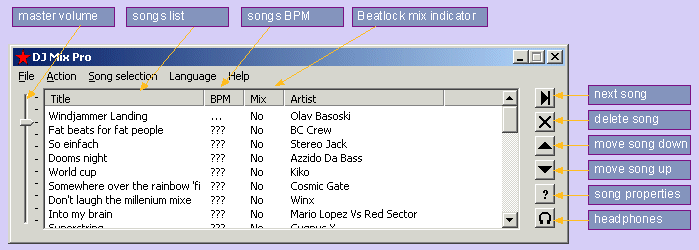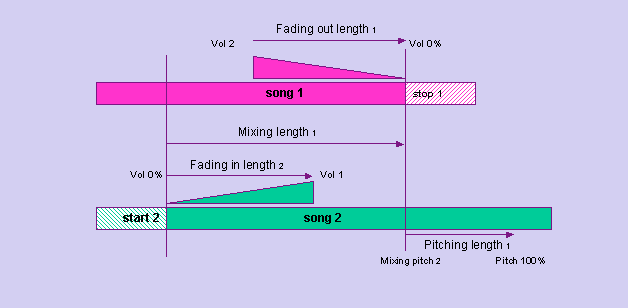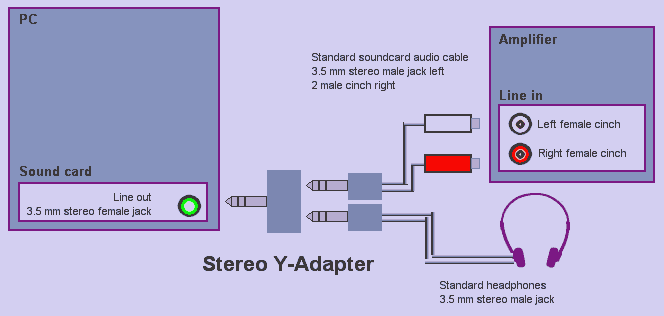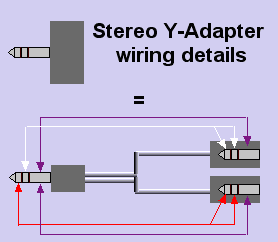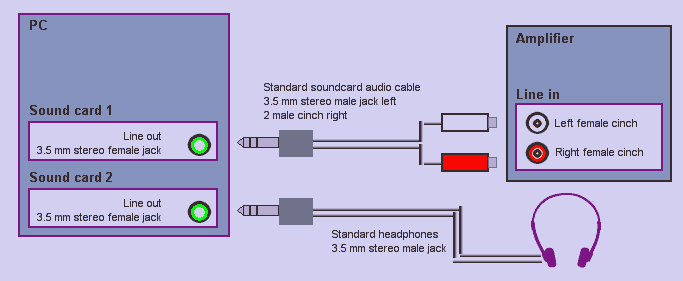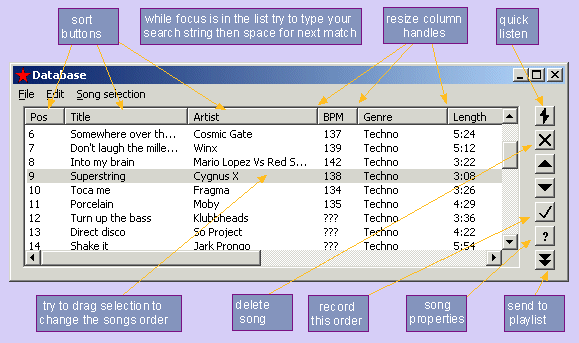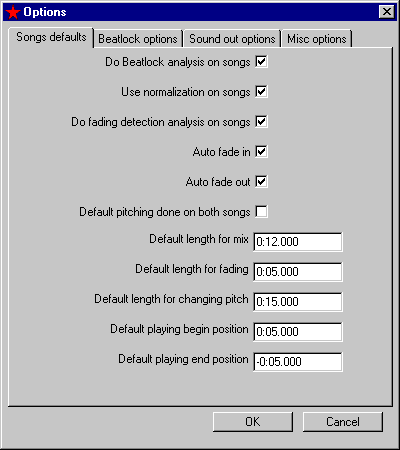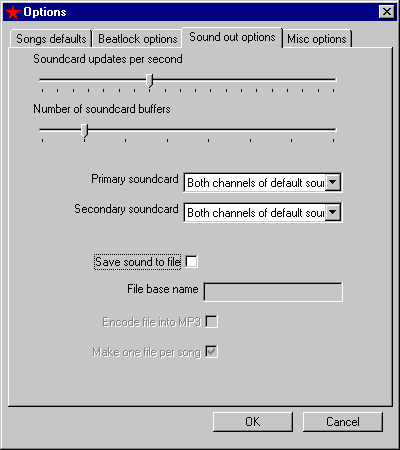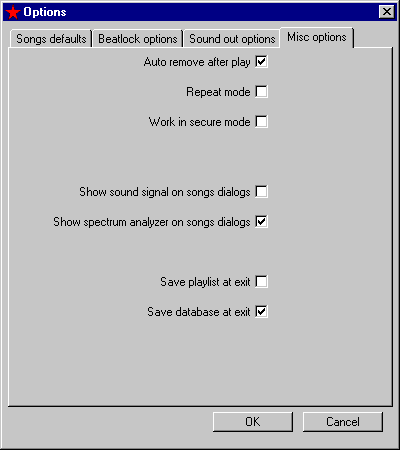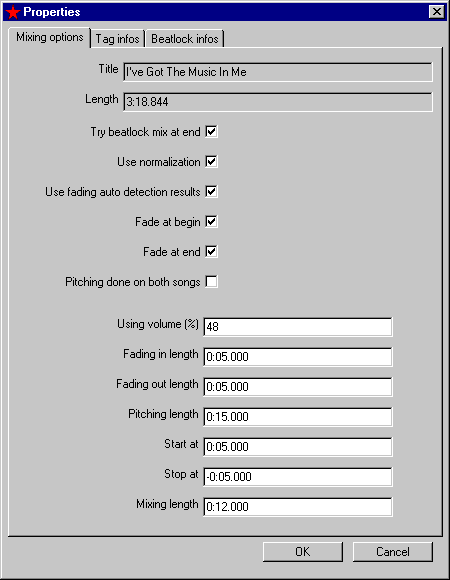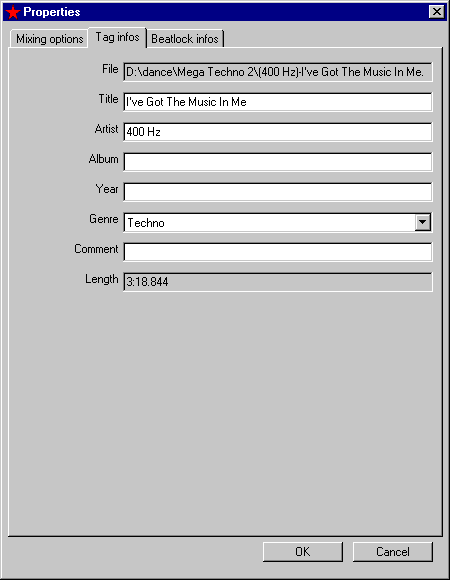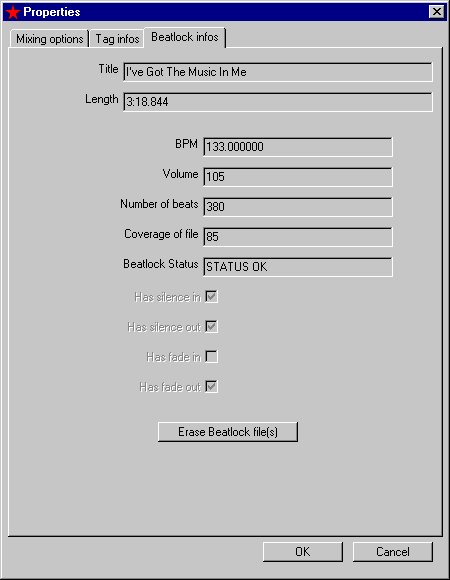 |
|
Mixing assisted by computer
|
is proud to present you the
 User guide
User guide
1 Welcome
2 Introduction to mixing
2.1 Non stop music
2.2 Beats
2.3 Beats Per Minute
2.4 Cross-Fading
2.5 Beat-Matching
2.6 DJ Mix Pro features
3 Installing DJ Mix Pro
3.1 Files
3.2 License
4 Music files
4.1 DJ Mix Pro compatible file formats
4.1.1 Music file formats
4.1.2 Song list file formats
4.2 Searching and importing files
4.2.1 In the database
4.2.2 In the play list
5 Play list
5.1 Play list display
5.1.1 Song titles
5.1.2 BPM
5.1.3 Mix
5.2 Managing the play list songs
5.2.1 Importing from database
5.2.2 Directly adding files
5.2.3 Saving play lists
5.2.4 Exporting song information
5.2.5 Exporting sound to disk (registered users only)
5.2.6 Moving songs
5.2.7 Deleting songs
5.2.8 Examining and setting song properties
5.3 Playing songs
5.3.1 Starting to play songs
5.3.2 Playing behavior
5.3.3 Stopping sound
5.3.4 Forcing transition now
5.3.5 Sending to Headphones listening mode
5.4 Mixing songs
5.4.1 Mixing behavior
5.4.2 Mixing settings
5.4.3 Default mixing settings
5.4.4 Taking control
6 Sound outputs
6.1 One soundcard, no headphones
6.2 One soundcard and headphones (mono)
6.3 Two soundcards and headphones
6.4 Tuning the sound output
7 Headphones listening mode
7.1 Objectives
7.2 Usage
7.2.1 Setting playing limits
7.2.2 Setting target volume
7.2.3 Setting lengths
7.2.4 Requesting beat matching mix
7.3 Trying the settings
7.3 Navigating from mix to mix
8 Database
8.1 Benefits
8.2 Database display
8.2.1 Database song titles
8.2.2 Database BPM
8.3 Managing the database songs
8.3.1 Adding files to the database
8.3.2 Saving a database
8.3.3 Moving songs in database
8.3.4 Resetting songs order
8.3.5 Deleting songs in database
8.4 Using the database songs
8.4.1 Sending to play list
8.4.2 Sorting songs
8.4.3 Finding songs in a huge database
8.4.4 Examining songs properties
8.4.5 Quick listening to songs
9 Beatlock Analysis
9.1 Definition
9.2 Behavior
9.3 Control and options
10 Miscellaneous features
10.1 Equalizers
10.2 Secure mode
10.3 Statistics
10.4 Sound pitching
10.5 Transporting Beatlock data files
10.6 ID3V2 tags handling
10.7 Command line options
11 Options reference
11.1 Song defaults tab
11.2 Beatlock options tab
11.3 Sound output options tab
11.4 Misc options tab
12 Song properties reference
12.1 Mixing options tab
12.2 Tag infos tab
12.3 Beatlock infos tab
13 Have fun

1 Welcome
Beatlock Technology is proud to present the DJ Mix Pro User Guide.
This document will help familiarize you with DJ Mix Pro. After reading
this you will fully understand playing and mixing music files in a very
easy and intuitive way. You should also be able to easily perform live DJing
if you have the correct cables.
Before computer based music, you typically had to have a lot
of equipment (several disc players, a turntable, plus amplifier and speakers)
and had to operate many buttons.
Now you can perform similar mixes with just one mouse click.

2 Introduction to mixing
We are not claiming DJ Mix Pro performs the best mixes around. Professional
DJs use their heart and feelings too.
But we think DJ Mix Pro handles ‘most’ mixes better than a just random
mix the way some players do, and performs rather good mixes if you
give it a little help.
If you are not a purist, mixing is not really very difficult. You just
have to sequence music in a pleasant way.
Here are basic rules.

2.1 Non stop music
The most important rule in mixing is non-stop music. You should have silence
only if you want it, because you need a pause.
When you are doing a series of songs, songs should play continuously, at
thesame perceptual volume, overlapping at the boundaries.

2.2 Beats
Beats induce the music tempo. They are usually made up of regular patterns
of drum hits, but can also be made up of the instrument’s notes themselves
in the event there are no drums.
The beats can be very easily heard in most dance music like Disco, Dance,
Rock, … It’s the BOOM BOOM BOOM in Techno or more discrete tching tching
tching in Jazz.
One objective of mixing is to keep people dancing, thus not disturbing
their rhythm any more than necessary. You have to work on clever song sequencing.
This is “your” work, and DJ Mix Pro can’t replace you for that.

2.3 Beats Per Minute
BPM stands for Beats Per Minute. It is a measure that gives you the music
tempo.
A song that BOOMs exactly twice per second will have a BPM around 120.
DJs use BPM to sequence songs that have similar tempo and organize clever
sequencing.

2.4 Cross-Fading
When overlapping 2 songs doing a mix, if the mix doesn’t occur at the first
song’s end, you will have to lower its volume gradually to zero, performing
a fade out.
Similarly if the mix doesn’t occur at the second song’s beginning, you
will have to start it silently then raise the volume gradually, doing a
fade in.
Fade in and fade out are important in the mix. Between fade in and fade
out, the time during which both songs are playing together is the mix.

2.5 Beat-Matching
Beat matching is a DJing technique that consists of having the beats of
the 2 songs occur at the same time during the mix. The audience then has the
feeling it is the same song.
The best DJs around do it, slowing or accelerating one of the 2 songs (pitching)
until the beats are in sync, then controlling the pitch to stay in sync
for several seconds. Performing this manually requires a lot of technique,
but gives very interesting mixes.

2.6 DJ Mix Pro features
DJ Mix Pro allows you to perform easy mixes, even beat matching mixes.
You can make real time mixes, quickly moving your mouse, doing all the
work manually
But you don’t have to. We rather suggest that you prepare the mixes “offline”
using ”headphones listening” mode, while other songs are playing on the
speakers.
Just let DJ Mix Pro do the tedious part (fade in, pitching, fade out) while
you concentrate on the creative part (which song to play next, how
long to make the mix, the fades). You can try your mixes offline, using headphones.
DJ Mix Pro will then reproduce the mixes you have created when the mix time
has come!
This method allows you to feel more confident, mixing/playing your choices
offline, letting the program do the difficult part. It helps you to become
a successful home DJ.
Even if you don’t want to do live DJing, DJ Mix Pro is still great
for playing music at home or in environments with no DJs, like bars, aerobics
classes or public events. Letting the program mix using the default settings
still gives reasonable results, sometimes surprising the audience
by changing songs without people noticing it.
The last popular usage is compilations production. DJ Mix Pro in its registered
version is also very good at producing 75 minutes of mixed songs that can
be used to fill an audio CD (using an external CD burning program).

3 Installing DJ Mix Pro

3.1 Files
The installation is pretty straightforward. Choose another location if
the default location doesn’t please you.
Nothing is put in the Windows registry or in external subfolders, so un-installation
is also really easy: either run the un-installation program or just delete
the installation folder.
DJ Mix Pro distribution is composed of several files, please do not modify
the original distribution. DJ Mix Pro cannot work as a standalone file.
The main files are:
- Cache folder: where Beatlock data files (.blk files) are stored
- Languages folder: internationalization files
- Plugins folder: (not much yet) visualization Plugins
- Skins folder: (not much yet) skins
- Htmldocs folder: documentation folder
- DJMixPro.ini file: DJ Mix Pro options (DJMixPro program options/settings are stored in this file)
- Autosave.m3v: DJ Mix Pro play list (Playlist is stored in this file automatically at application termination if this feature is enabled)
- Autosave.m3d: DJ Mix Pro database (a list of your music files “Mp3s,Wavs,etc.” are stored in this file automatically at application termination if this feature is enabled)
All data files (m3d, m3v, blk) are text files and are upward compatible.
They cause no problem when upgrading the program.

3.2 License
If you bought a license you can unlock the demo version using the license
file data.
Follow the instructions you have received and enjoy the full unlimited
features of the program:
- Unlimited mixes
- Unlimited BPM analysis
- Saving sound output to file(s)

4 Music files
DJ Mix Pro works with music files on disk. The files can be remote (on
a windows network computer, but not through internet) or on an ISO CDROM,
but we strongly suggest you use files from your hard drives only.
DJ Mix Pro does not support reading audio CDs.

4.1 DJ Mix Pro compatible file formats
DJ Mix PRO handles many files types, and creates some too.
Here are the supported file formats:

4.1.1 Music file formats
Mp3 files: all mp3 files are supported
Ogg vorbis files: all vorbis files are supported
Wav files: simple wav files are supported (uncompressed, no loops). Most
Wav files are like this.
Wma files: unprotected wma files are supported. Choice to make a Wma file
protected or not is done at file creation time, so if your file is already
protected, there is nothing you can do about it.
Other music file formats (voc, raw...) are not supported.

4.1.2 Song list file formats
M3u files: are winamp play list files. This file format has changed a lot
and can still evolve, but DJ Mix PRO can load most m3u files.
M3v files: are DJ Mix Pro play lists files. This file format is used to
load/save a DJ Mix Pro play list with all the mixing settings.
M3d files: are DJ Mix Pro database files. This file format is used to load/save
a DJ Mix Pro song database.

4.2 Searching and importing files
The first task of a DJ Mix Pro user will be to give the program some music
files to play. This can be done either in the database or in the play list.

4.2.1 In the database
In the database you can directly use the Windows explorer and your mouse,
drag and drop some music files or song lists into the database window.
You can also have the database search for files (music files and song list
files) under a given folder hierarchy.
Or you can have the database load specific files, either music files or
song list files.

4.2.2 In the play list
In the play list you can directly use the Windows explorer and your mouse,
drag and drop some music files or song lists into the play list window.
You can also send selected items in the database window to the playlist.Or
you can have the play list load specific files, either music files or song
list files.
Files loaded directly from the play list will be inserted in the database
as well.

5 Play list
The play list is the core of DJ Mix Pro. It is the list of songs which
are queued to play and mix.

5.1 Play list display
The play list displays 4 columns. Columns are simpler than in the database
because no search information is needed here.
Columns can be resized (thus hidden) according to your needs and the program
will remember the column sizes.
The database displays 10 columns. Columns are taken from the ID3 tags,
file name, time length and BPM once computed.

5.1.1 Song titles
The title is taken from the ID3 tag.
If both ID3V1 and ID3V2 tags are present ID3V2 overrides ID3V1.
If no tag is present, title is taken from the file name.

5.1.2 BPM
DJ Mix Pro will try to compute the BPM for every file in the database (see
Beatlock Analysis chapter).
If you are using the demo version, DJ Mix Pro will try to compute the BPM
for the first 11 files loaded only.
Before computation occurs, the BPM displayed will be ‘???’
During computation occurs, the BPM displayed will be ‘…’

5.1.3 Mix
This column tells you if this mix (as currently defined) will be a beat
matching mix or not. If no beat matching mix is possible you can see the reason
by switching to ”headphones listening” mode.

5.2 Managing the play list songs

5.2.1 Importing from database
Songs can be imported from the database. See ‘Database: Sending to play
list’. Songs imported from the database are considered new and take their
mixing settings from the default mixing settings (See Mixing songs: Default
mixing settings)

5.2.2 Directly adding files
Dropping or opening a .m3v file appends to the current play list. Each
song’s mixing settings are also reloaded from the m3v file.
Dropping or opening m3u files or music files also adds to the play list.
Files added this way are new and take their mixing settings from the default
mixing settings (See Mixing songs: Default mixing settings).
All files directly added to the play list are also added to the current
database. It merges the songs with the current database, adding the new
music files to the ones already there.

5.2.3 Saving play lists
If you want to save the play list as is, including the mixing settings,
save the play list in a m3v file.
By default the play list is NOT automatically saved to autosave.m3v when
the program stops, but you can turn this on.
Be careful to save BEFORE playing because the default playing mode automatically
removes the songs from the playlist that have been fully played.

5.2.4 Exporting song information
If you want to save the play list song names, artist and length (to print
it for example), export the play list in a txt file.
Again be careful to export BEFORE playing.

5.2.5 Exporting sound to disk (registered users only)
If you want to burn a mixed CD, here is how to proceed.
Burning an audio CD requires you to provide your burning software with
70 minutes or so of wav file(s).
Each file will be a track on the audio CD. You can have a single
track, but it is generally much better to have one track per song.
This section explains how to produce the wav file(s) that you need in order
to burn, not how to burn them, because this is the responsibility of the
burning software.
First you will need 800 MB of disk space.
Then you need to have the play list completely setup, mixes already defined
and checked (using the ”headphones listening” mode is a good idea).
You might also want to check the playing length in the statistics, so that
you don’t have more music mixed time than your CD can contain.
When this is done, and BEFORE playing, you need to go to the options window,
sound output tab.
· Check that the primary soundcard is mapped to both channels of any available soundcard on your system… “Default” is fine(you want to make a stereo CD).
· Check the “save sound to file box”
· Don’t check save as mp3
· Check save one file per song if you want a separate file for each song or leave unchecked for a single wav file containing the entire playlist mix .
· Enter the base file name. This is the tricky part, because base file name IS NOT JUST A FILE NAME but rather the complete path and file name, possibly using metacharacters.
If you input just F:\mixedcd\track, wav files will be generated like this:
- F:\mixedcd\track_001.wav
- F:\mixedcd\track_002.wav
- F:\mixedcd\track_003.wav
- ….
You can use metacharacters to get intelligent file naming: %a for artist
name, %t for title, %f for original file name, %% for percent.
If you input c:\cdtodo\song\(%a) - %t, wav files will be generated like
this:
- F:\ cdtodo\song\(toto) – africa.wav
- F:\ cdtodo\song\(police) – message in a bottle.wav
- F:\ cdtodo\song\(kiss) – I was made for loving you.wav
- ….
Now in the Misc options tab, you must turn off ‘Repeat mode’. You might
want to also turn off ‘Auto remove after play’.
When done, hit OK to save the changes.
Then in the play list window, start playing. Wave files will be produced
while the sound is playing. Let the program play the play list entirely.
If you stop the sound you will have to play from the start again.
When the entire play list has finished playing, go back to options and
turn off the ‘save sound to file box’ and hit OK. The wav files should be
all created.

5.2.6 Moving songs
Push the up or down buttons 
 to move the songs selected in the play list. Or just drag the selection
up or down.
to move the songs selected in the play list. Or just drag the selection
up or down.

5.2.7 Deleting songs
Hit the delete button  (or shortcut defined for this action, by default control-D) to remove all
selected songs from the play list. This does not delete the actual song file
but removes its reference in DJ Mix Pro play list. This does not delete the
song reference in the database either.
(or shortcut defined for this action, by default control-D) to remove all
selected songs from the play list. This does not delete the actual song file
but removes its reference in DJ Mix Pro play list. This does not delete the
song reference in the database either.

5.2.8 Examining and setting song properties
Each song has physical properties, like the mp3 ID3 tags, the length, the
Beats information, …
Hit the properties button  (or shortcut defined for this action, by default control-P) to open the
song properties window.
(or shortcut defined for this action, by default control-P) to open the
song properties window.
You can modify the Beatlock data if you need to (double the BPM / divide
by 2 the BPM, shift by ½ beat), clear the Beatlock data.
You can tag song files in this window. If you had selected several songs,
you can even tag multiple files (except for title tag). In this case, fields
displaying ‘(multiple values)’ will be left unchanged.
You can modify the mixing settings for the songs in this tab. If you have
selected several songs, you can modify mix settings for all the selected
songs. In this case, fields displaying ‘(multiple values)’ will be left unchanged.
This is not however the most convenient place to change an individual mixing
setting. You should read the ”headphones listening” mode chapter to learn
an easier way to setup an individual mix.

5.3 Playing songs

5.3.1 Starting to play songs
Just hit ‘mix with next’ button  and the first selected song will start playing. If no song is selected,
the first song will start playing.
and the first selected song will start playing. If no song is selected,
the first song will start playing.
You can also double click on the song you want to play.

5.3.2 Playing behavior
Once playing has started, songs will be played in sequence. A mix will
occur between every song after the first.
By default, once a song has completed playing, it is removed from the play
list, but you can change this behavior in the options.
You can also choose (under options) to have a repeating play
list, mixing the last song with the first one.

5.3.3 Stopping sound
If you close the song currently playing, it will stop the sound with no
mix.

5.3.4 Forcing transition now
You can force song transition in 2 ways:
If you double click another song while playing, it will immediately stop
the currently playing song and start the new song. This is not a graceful
way to force a transition but it is the quickest way. You can also force
a mix to occur immediately, which is nicer but longer. See ‘Mixing song with
next’ and ‘Mixing song with selected’.

5.3.5 Sending to Headphones listening mode
All songs in the play list can be heard in headphones, and mix can be heard
offline, while speakers are playing.
Select the first song to mix in the playlist and hit the ´Send to headphones´
button  .
.

5.4 Mixing songs
The real power behind DJ Mix Pro resides in its easy mixing capabilities.

5.4.1 Mixing behavior
Whenever a transition between songs occurs, either because you triggered
it or because the mixing time has come, the following events occur:
- The second song is loaded and displayed in a
new window a few seconds before the mix. Playing position is set to the begin
position in the new song.
- The new song starts playing and performs its
fade in.
- The old song performs its fade out and disappears.
Now, if a Beatlock mix was possible and requested, during the time where
the mix occurs, the program changes the tempo of the new song and slightly
moves the begin position so that the beats of both songs matches.
Tempo of the new song will then smoothly go back to normal.

5.4.2 Mixing settings
All mixes are controlled by a few parameters taken from the properties
of the 2 songs (see Play list: Examining and setting song properties):
First song properties:
- Stop at
- Fade out length
- Mixing length
Second song properties:
- Start at
- Fade in length
- Pitching length
Advanced properties also control these behaviors:
- Use volume normalization
- Perform a beat matching mix
- Perform or don’t perform fade in / fade out

5.4.3 Default mixing settings
New songs added to the play list (except songs loaded from a m3v file)
will take their properties from the Options window, Songs default tab.
You can change the song’s default before adding new songs, but once in
the play list, you have to use the song properties window or ”Headphones
listening” mode to modify the mixing settings.

5.4.4 Taking control
You usually have to do nothing to perform the mix. Everything is time event
driven and the mix will occur when the playing position reaches stop at
minus mixing length.
But you still can decide to start a mix immediately if you want to.
Just hit ‘Mix with next now’  and the next song in the play list will popup. The mix will occur within
a few seconds.
and the next song in the play list will popup. The mix will occur within
a few seconds.
You can also force a mix with another song: select it in the play list
and hit ‘Mix with next now’  while pressing the
while pressing the  key.
key.

6 Sound outputs
DJ Mix Pro is designed to work with one or two soundcards. It is recommended
that you use headphones when doing live DJing, although this is not mandatory.
In the options window, sound output tab, you can choose the soundcard for
the play list output (Primary soundcard) and the soundcard for ”headphones
listening” mode output (Secondary soundcard).

6.1 One soundcard, no headphones
In this mode, everything played in ”headphones listening” mode will play
on the speakers. This implies you don’t use headphones while DJing.
Map both primary and secondary to both channels of your soundcard (this
is the default).

6.2 One soundcard and headphones (mono)
In this mode, the soundcard output must be split in 2 mono channels. This
will require you to make or buy an audio “doohicky” (a Stereo Y-Adapter).
This device is composed of a male stereo 3.5mm jack you plug into the soundcard
on one side, and of 2 female stereo 3.5mm jacks on the other side. On these
2 jacks, one is the left channel of the soundcard and one is the right channel.
You plug your headphones into one and the hi-fi cable into the second.
Map the “primary soundcard” to the left OR right channel (your choice)
and the “secondary soundcard” to the remaining channel.

6.3 Two soundcards and headphones
This is the preferred mode. You have one soundcard dedicated to the (hi-fi)
speakers and one to the headphones.
Buying a 2nd soundcard is not really expensive and is worth it if you plan
to DJ a lot.
Map the “primary soundcard”to the first soundcard on your system and “secondary
soundcard” to the other soundcard on your system.

6.4 Tuning the sound output
The soundcard plays continuously, buffers, that are built and sent
by DJ Mix Pro.
Buffers are prepared in advance, covering by default ½ second of
sound.
If your machine is slow and attempts another parallel activity, the soundcard
can run out of buffers before DJ Mix Pro gets enough CPU cycles to prepare
and send more buffers. You then hear glitches.
You can overcome this by playing with the sound output options. Increasing
the buffers will make DJ Mix Pro less responsive but more tolerant to CPU
bursts of activity.

7 Headphones listening mode

7.1 Objectives
The term “headphones listening” mode can be misleading because the sound
is not in headphones if you choose the ‘One soundcard, no headphones’ configuration.
The “headphones listening mode” mode is designed to see, listen to
and modify individual mixes.

7.2 Usage
Once you have defined the playlist order, you can see and control all the
mixes using the ”headphones mode” windows.
Select the first song to mix in the playlist and hit the ´Send to headphones´
button  .
.
Not all buttons are available if you have two songs loaded in ”headphones
mode”, because you are restricted to the mix between these two songs.
You can then go from mix to mix forward or backward.
Close the ”headphones mode” windows when finished.
You have visual information of the beat awareness of the program
in the bar drawn on the bottom of the black zone.
- Green zones are beat aware zone corresponding to the BPM displayed
in the main window list.
- Purple zones are zones with BPM different to the BPM displayed in the
main window list. Look at the local BPM info (in red) to know the local BPM.
- Red zones are zones with no beat detected.

7.2.1 Setting playing limits
You can set the points where the song will start and stop.
If needed, pause the song using  .
.
You can have fine control on the playing position cursor on a paused song
using the rewind  and forward
and forward  buttons :
buttons :
Once a song BPM is known, what we call the interval unit is exactly one
beat. Otherwise, this interval unit is half a second.
Clicking, you move the position 10 seconds
Clicking while the  key is pressed, you move the position 8 interval units
key is pressed, you move the position 8 interval units
Clicking while the  key is pressed, you move the position 1 interval unit
key is pressed, you move the position 1 interval unit
Clicking while the  key is pressed, you move the position 1/8 interval unit
key is pressed, you move the position 1/8 interval unit
Move the playing position cursor to desired start position and hit the
‘Start here’ button  .
.
Move the playing position cursor to desired stop position and hit the ‘Stop
here’ button.

7.2.2 Setting target volume
You can set the target sound volume for the 2 songs. That means the volume
that will be set at the end of fade in. Just adjust the volume cursor.

7.2.3 Setting lengths
You can set the fade out length and mixing length on the first song and
the fade in length on the second song. Just play with the cursors.

7.2.4 Requesting beat matching mix
You can request the mix to be a beat matching mix  or not
or not  . Toggle the behavior clicking on the star button . If this is possible,
the icon will display a smiley face. Otherwise the icon indicates that a beat
matching mix is not possible.
. Toggle the behavior clicking on the star button . If this is possible,
the icon will display a smiley face. Otherwise the icon indicates that a beat
matching mix is not possible.

7.3 Trying the settings
Hit ‘Listen to fade in’ (left  ) in the second window to listen to the mix fade out only.
) in the second window to listen to the mix fade out only.
Hit ‘Listen to fade out’ ( right  ) in the first window to listen to the mix fade in only.
) in the first window to listen to the mix fade in only.
Hit ‘Listen to mix with next’ in the first window or ‘Listen to mix with previous’
in the first window or ‘Listen to mix with previous’ in the second window to listen to the full mix between the 2 songs currently
displayed.
in the second window to listen to the full mix between the 2 songs currently
displayed.
Retry your mix until you´re satisfied with it. The mix will happen
on the primary output exactly the same way you heard it on the secondary output.
It might happen that beatlock mix is not possible.
Look at the status icon to know why.
If BPM differ too much, you might have to change your playlist
order if you still want a Beatlock mix.
If the icon says there are no beats in one of the song, you will
have to move the fade in or out in the green zone
Retry your changes until the icon changes to happy face
Here are Beatlock mix statuses :

|
One of the 2 songs failed to beatlock, so
no beatlock mix |
| One of the 2 songs is not beatlocked yet |
| Okay, Beatlock mix ready |
| Wew, BPM differ too much |
| No beats around ending pos of left song |
| No beats around starting pos of right song |

7.3 Navigating from mix to mix
You can navigate from mix to mix, in the order defined by your playlist.
If you hit ‘Listen to mix with next’ in the second window, you will hear the next mix (second song becomes
first and and the following song in the play-list is loaded as second).
in the second window, you will hear the next mix (second song becomes
first and and the following song in the play-list is loaded as second).
If you hit ‘Listen to mix with prev´  in the first window, you will hear the previous mix (first song becomes
second and and the previous song in the play-list is loaded as first).
in the first window, you will hear the previous mix (first song becomes
second and and the previous song in the play-list is loaded as first).

8 Database
The database window is not mandatory. You can close it if you don’t want
to use it. But it is a very useful tool when live DJing.

8.1 Benefits
The database window is used to manage your music files. It is designed
to handle many of them (several thousand songs can be put there) and quickly
sort or find the songs you are looking for.

8.2 Database display
The database displays 10 columns. Columns are taken from the ID3 tags,
file name, time length and BPM once computed.
Columns can be resized (thus hidden) to suit your needs and the program
remembers the column sizes.

8.2.1 Database song titles
The title is taken from the ID3 tag.
If both ID3V1 and ID3V2 tags are present ID3V2 overrides ID3V1.
If no tag is present, title is taken from the file name.

8.2.2 Database BPM
DJ Mix Pro will try to compute the BPM for every file in the database (see
Beatlock chapter).
If you are using the demo version, DJ Mix Pro will try to compute the BPM
for the first 11 files loaded.
Before computation occurs, the BPM displayed will be ´???´
During computation occurs, the BPM displayed will be …

8.3 Managing the database songs

8.3.1 Adding files to the database
Dropping a .m3d file or music files into the database window appends to
the current database. It merges the songs, adding the new music files
while leaving the ones already there.
Searching for files takes all supported files (m3d, m3u, m3v, wav, mp3,
ogg, wma) in the folder hierarchy you select and adds the files to the database.
Using “Open a database” you can add all selected files to the database.
You can add .m3d files or music files directly by dragging and dropping them
into the database window. You can add one file or several files at a time.

8.3.2 Saving a database
You can save the current database to a m3d file. By default the database
is automatically saved to autosave.m3d when the program stops, but you can
turn this off.

8.3.3 Moving songs in database
Push the up or down buttons 
 to move the songs selected in the database. Or, just drag the selection
up or down.
to move the songs selected in the database. Or, just drag the selection
up or down.

8.3.4 Resetting songs order
Hit the ‘record this order’ button  to renumber the database lines. This is useful for saving a custom order
after sorting.
to renumber the database lines. This is useful for saving a custom order
after sorting.

8.3.5 Deleting songs in database
Hit the delete button  (or shortcut defined for this action, by default control-D) to remove all
selected songs from database. This does not delete the actual song file but
removes its reference from the DJ Mix Pro database.
(or shortcut defined for this action, by default control-D) to remove all
selected songs from database. This does not delete the actual song file but
removes its reference from the DJ Mix Pro database.

8.4 Using the database songs

8.4.1 Sending to play list
The purpose of the database window is to send songs to the play list queue.
Hit the ‘Send to play list’ button  (or shortcut defined for this action, by default control-B) to append the
selected songs to the play list.
(or shortcut defined for this action, by default control-B) to append the
selected songs to the play list.
You can also double click on songs to send them to the play list.
Songs enqueued in the play list will be played in order, but you can change
this order and the way the mix is performed until that particular
mix is executed.

8.4.2 Sorting songs
Click on any column title to sort the songs in the database. The first
click will sort ascending but a second click will sort descending.
If you want to sort using several keys (for example by BPM then by title)
click on the columns in reverse key order (for the example, click title
then click BPM)

8.4.3 Finding songs in a huge database
If you want to look for a song, you can open the search window, type your
search string and hit search.
Search will show you the cell matching the input string. Hitting next will
search down the column, then the next column, top to bottom and so on, until
next match is found.
When searching for a match, only letters and numbers are significant. It
is not useful to type spaces and characters because they are ignored.
A quicker way to search is to put the input focus on the list (click in
the list once).
Then directly type your search string without spaces. The selection will
move to the next match. Hit the space bar to go to next match.

8.4.4 Examining songs properties
Each song has physical properties, like the mp3 ID3 tags, the length, the
Beats information, etc…
Hit the properties button  (or shortcut defined for this action, by default control-P) to open the
song properties window.
(or shortcut defined for this action, by default control-P) to open the
song properties window.
You can modify the Beatlock data if you need to, (double / divide by 2
the BPM, shift by ½ beat), or clear the Beatlock data.
You can tag song files in this window. If you had selected several songs,
you can even tag multiple files (except for title tag). In this case, fields
displaying ‘(multiple values)’ will be left unchanged.

8.4.5 Quick listening to songs
If you hit the quicklisten button  , you can listen to the selected song in the headphones. This allows you
to identify a song if tag information or file name are not explicit, without
having to stop the sound from the speakers.
, you can listen to the selected song in the headphones. This allows you
to identify a song if tag information or file name are not explicit, without
having to stop the sound from the speakers.

9 Beatlock Analysis

9.1 Definition
One task performed by DJ Mix Pro is to compute the beats and BPM of all
known files.
This task is called Beatlock analysis or beatlocking.
This is done automatically in the background, you do not have to bother
about beating on your keyboard.
Beatlock mix (beat matching mix) becomes possible whenever one song and
the next song in a row are succesfully Beatlock analysed, and are BPM compatible
(10% of tempo difference or less, configurable in the options dialog) as well. This what is shown in the mix
column.

9.2 Behavior
DJ Mix Pro will take all files in the order they were loaded and check
if there is already a Beatlock data file (blk).
If yes, it will load data from this file. Otherwise it will perform a full
file analysis. The analysis takes some time (lets say about one minute per
song), but is stored permanently once complete in a blk file.
BPM column shows the activity being done on files. If ‘…’ is displayed,
file analysis is being done. If a BPM or ‘BAD’ is displayed, analysis or data
load occurred and nothing more will be done on the file, unless you delete
the Beatlock data.
| ... |
doing Beatlock analysis |
| --- |
song does not use Beatlock analysis |
| BAD |
song failed to be Beatlock analysed |
| ??? |
song not analysed yet |

9.3 Control and options
You may turn off the Beatlocking if you think you do not need it.
You can stop all analysis (if any) by selecting the ‘Stop beatlocking’
menu item.
Resuming will occur when you select ‘Start beatlocking’ menu item.
You may also turn the ´Do beatlock analysis on songs´ off in
the global options dialog before you actually load songs.
BPM analysis is done between lower and upper BPM limits found in the options.
Avoid giving ranges that are too large because DJ Mix Pro can confuse BPM
and its double or half.

10 Miscellaneous features

10.1 Equalizers
There are 2 levels of equalizers in DJ Mix Pro. The master equalizer is
global and is used for all songs. You can access it in the action menu.
Even if you close the window, it is still used until you reset all track
bars to 0 Db.
Each individual song in the play list can also have a local equalizer.
Local equalizer settings are stored in the m3v files as well as mixing settings.

10.2 Secure mode
There is a special playing mode in DJ Mix Pro (Secure Mode) that asks for
a confirmation anytime the user selects on option which can cause the sound
to stop. It can help avoid catastrophic glitches caused by accidental
actions on the part of the user. This is especially useful with mouse pads.
Try it and use it if you like it.

10.3 Statistics
The statistics window takes all songs in the play list and computes the
sum of all the songs length. It also computes the total playing length (which
is different since there is overlapping when mixing).

10.4 Sound pitching
Pitching digital sound is not easy. We have tried 3 different algorithms
for pitching, none of which is perfect.
You have the choice between
- ‘Classic sound stretching’, that doesn’t eat
much CPU but changes the tonality. Plus introduces a slight perturbation in
very high frequencies.
- High quality stretching does the same but consumes
more CPU and fixes the high frequencies problem.
- Pitch scaling doesn’t eat much CPU, doesn’t
change the tonality, but produces some reverberation effects with slow tempos.
We left the choice up to you.

10.5 Transporting Beatlock data files
If you wish to use DJ Mix Pro on several computers and want to share Beatlock
data and music files, you will have to store the Beatlock data next to the
music files.
You can then copy or access the Beatlock data within the same folder
as the music file.
To do this, on the file menu, select Action, Options, select the Beatlock
Options tab and put a check mark next to “Leave beatlock data near
mp3 files”

10.6 ID3V2 tags handling
ID3 V2 tags are something newer, more complex and more fragile that ID3V1
tags.
It takes also more time to read them.
This is the reason why we choose to turn this processing off by default.
If you want to use these tags, turn the option on.

10.7 Command line options
You can run the program with arguments, to provide input songs for example.
The most obvious usage is to give file names as arguments. The program will load them in the playlist.
You can also use these options to control the program from a script.
Some options are designed
to override the options of the options window.
Usage : DJMIXPRO [ options ] [mp3_file1] [mp3_file2] ...
If files are provided on the command line, play will start by default.
Options :
- --play
- --noplay
- --nodbscreen
- --dbscreen
- --noautoload
- --exitwhendone
--play : Will force the player to start. (default when
files on the command line)
--noplay : prevent player from starting. (default when
no files on the command line)
--nodbscreen : Will prevent Database screen from showing.
(default when files on the command line, overrides the ´Options dialog´
value)
--dbscreen : Will force Database screen to show ( overrides
the ´Options dialog´ value)
--noautoload : Will prevent autosaved playlist to load
and save. (overrides the ´Options dialog´ value).
--exitwhendone : Program will exit after all songs have
played. (but beware , will not work if ´Loop mode´ option is enabled)

11 Options reference
Here are a lot of interesting options plus default values that are applied
to songs loaded in the playlist.

11.1 Song defaults tab
Do beatlock analysis : new songs will have their ´Try
Beatlock Mix at end´ property set to this. Means they will be Beatlock analyzed
and Beatlock mixed if possible.
Do volume normalization : new songs will have their ´Use
normalization´ property set to this. Means that songs will be all played
at the same perceptive volume.
Do fading detection analysis : new songs will have the
use fading detection property.
Do fade in : new songs will have this ´Fade at begin´
property set to this. Songs will perform a fade in when starting to play
Do fade out : new songs will have the ´Fade at end´ property
set to this. Songs will perform a fade out before stopping.
Do pitching done on both songs : new songs will have this
value for ´pitching done on both songs´ property.
Mixing length : new songs will have this mixing length
property.
Fading length : new songs will have this fading in/out
length property.
Pitching length : new songs will have this ´pitching length´
property.
Playing begin position : new songs will have this ´start
at´ property.
Playing end position : new songs will have this ´stop at´
property. This field accepts negative values, that are relative to the end
of the song.
All time length text controls have this syntax :
mm:ss.xxx
where mm are minutes, ss are seconds and xxx are milliseconds.
valid inputs examples follow :
| 100 |
100 seconds |
| 1:40 |
100 seconds |
| 100. |
100 seconds |
| 1:40.00 |
100 seconds |
| .40 |
40 ms |

11.2 Beatlock options tab
Use smart limits : allow song start and stop limits
to move (in the limit defined by the smart limit maximum) while trying to
perform a Beatlock mix.
Smart limit maximum : maximum move of start or stop
of a song when allowing smart limits.
Limit BPM detection to : upper and lower bounds of
BPM search. Limiting BPM width search avoid some BPM bad guesses and helps
DJ Mix Pro to Beatlock better.
Tip : it´s a good idea not to let upper limit be greater
than ( lower limit * 2 ) since BPM detection easily mistakes with half or
double BPM.
Allow tempo adjustment of percent : here you define
the pitch change limits. See a mix occurs for more details.
Tip : Allowing changes more than 8 % usually leads
to ugly results.

11.3 Sound output options tab
Sound out options : Many of the items on this tab
will be grayed when sound is playing. You can change them at silence time
only.
Soundcard updates per second : choose the number of
times per second the soundcard receives sound buffers. If you choose too many
times per second (more than 12 for example) your sound system will become
CPU stress sensitive and may play dirty sound, but having many updates per
second makes the program more reactive because you reduce the commands delay.
Number of soundcard buffers : choose the number of
buffers the program uses. If you choose too few buffers, the program might
become out of buffers if another program uses much CPU, but having few buffers
makes the program more reactive because you reduce the commands delay.
Primary soundcard : sound output for songs in playing
mode. It can be any of your system soundcard channel(s) .
Secondary soundcard : sound output for songs in headphone
mode. It can be any of your system soundcard channel(s).
Note : if you have 2 soundcards, easy, one output
per card. If you just have one soundcard, you can decide to map the 2 outputs
on the same soundcard in stereo, but you will have reduced live DJ mixing
liberty since you won´t be able to use headphone mode while music is playing.
You can also decide to map one output per channel and to use all modes in
mono. It´s up to you.
Tip : a second soundcard is less than 40 USD on a
standard PC ...
Save sound to file : when checked, sound played on
primary card is saved to .wav files. This button will be grayed if sound is
already playing or if you are using the demo version.
Beware : this will work well only if you have mapped primary soundcard
on BOTH channels.
Also note that if you have mapped secondary soundcard on the same physical
soundcard as primary, you´ll save everything playing in headphone mode as
well. In this case you should turn on saving only when you´re finished setting
up your mixes and not use headphone mode while saving.
Base file name : THIS IS NOT JUST A FOLDER NAME but
rather complete path and name used when saving to file. Program automaticly
adds _001.wav, _002.wav, etc ... if not using metacharacters. You can use
metacharacters to get intelligent naming : %a for artist name, %t for title,
%f for original file name, %% for percent.
Example : basename c:/cdtodo/song will produce c:/cdtodo/song_001.wav,
c:/cdtodo/song_002.wav while basename c:/cdtodo/(%a) - %t will produce c:/cdtodo/(artist)
- song.wav
Encode file into MP3 : force saved files to be MP3
files (not recommended). Requires the Blade encoder library in the system
PATH.
Make one file per song : if not checked, sound is
saved in one file until sound stops. If checked, sound is saved to many
wav files, each finishing in the middle of each mix.

11.4 Misc options tab
Auto remove after play : remove song from playlist
when done (incompatible with repeat mode).
Repeat mode : automaticaly play first song again after
last song. This is the endless mode (incompatible with auto remove after
play).
Work in secure mode : special mode designed to prevent
any mistake leading to sound stopping without mix. Shows a confirmation window for every dangerous action.
Show sound signal on songs dialog : toggles the signal
displaying on songs windows.
Show spectrum analyzer on songs dialogs : toggles
the spectrum analyzer displaying on songs windows.
Save playlist at exit : automaticaly saves the playlist
on exit. Automatically load playlist on program launch (playlist is saved
in autosave.m3v).
Save database at exit : automaticaly saves the database
on close. Automatically load database on opening (database is saved in autosave.m3d).
Show database at startup : automaticaly show database
on program startup.
Try to use ID3V2 tags : turn on the search for ID3V2
tags. (otherwise, only ID3V1 search but way faster!).

12 Song properties reference
Here is the most complex window of djmixpro. Do not be scared by the many
fields in the window, as it will become clearer very soon.

12.1 Mixing options tab
Note : the next two fields do not appear when properties
of several songs are displayed at the same time.
Title : the song´s title if the file provides a mp3
title tag.
Length : the song´s length.
Note : the following fields appear even when properties
of several songs are displayed. In such a case, if all songs have the same
property value, the value is displayed. If songs have different property values,
no value is displayed. Modifications apply only on properties that are set
(not in indeterminate state).
Try Beatlock mix at end : this song is going to be
analysed by the Beatlock routines. At the ending position, djmixpro will try
to perform a Beatlock mix between this song and the next in the list.
Use normalization : at Beatlock analysis time, the
song perceptive volume will be computed. The song volume will be adjusted
at play time so that every song has perceptualy about the same volume.
Use fading auto detection results : this song is
going to be analysed by a fading search routine. If fading in/out already
occurs within the song, no fading in/out is performed by DJ Mix Pro. If not
checked or if not starting at pos 0/stopping at end of song , the ´Use fade
in/out´ are used to determine if djmixpro has to perform fade in/out rather
than the ´Use Fading auto detection results´ .
Fade at begin : make song volume rise smoothly from
0 to about 50% when song starts. Note that when use fading detection is checked
and song starts at position 0, this property is no used. A fade in is done
if no fade in was detected in the song.
Fade at end : make song volume smoothly fall to 0%
when song stops. Note that when ´Use fading detection´ is checked and song
stops at end, this property is no used. A fade out is done if no fade out
was detected in the song.
Pitching done on both songs : if checked, both songs
will change their pitch when mixing. If not checked, only the new one will.
Changing pitch of both songs, you will be able to mix more songs togeither
since the 2 songs allow about 16% pitch change instead of 8% with a single
song.
Using volume (percent) : Target volume after fade
in (default 50%) . Is automaticaly set if you use normalization. Is overridden
if you touch the playing song´s volume control.
Fading in length : length of fade in ( time to rise
from 0 to used volume)
Fading out length : length of fade out ( time to
go down from used volume to 0)
Pitching length : length of pitch change for Beatlock
mixes ( time to go from 100 to target pitch or from target pitch to 100%)
Start at : position within song where mix starts.
This doesn´t apply for songs not started by a mix.
Stop at : position within song where mix stops. Can
be a negative value if relative to the end of the song.
Mixing length : length between beginning of next
song´s fade in and end of current song´s fade out

12.2 Tag infos tab
Note : the following fields do not appear when the
properties of several songs are displayed. In such a case the window is empty.
File name : the song´s file name and location.
Note : the 6 following fields can be edited to change
the tags of the song.
Title : the song´s title tag.
Artist : the song´s artist tag.
Album : the song´s album tag.
Year : the song´s year tag.
Genre : the song´s genre tag.
Comment : the song´s comment tag.
Length : the song´s length.

12.3 Beatlock infos tab
Note : the following fields do not appear when properties
of several songs are displayed at the same time.
Title : the song´s title if the file provided a mp3 title tag.
Length : the song´s length.
BPM : this song´s BPM. Available only if Beatlock status is STATUS OK
Volume when normalized : song computed volume level for automatic volume match.
Number of beats : the number of beats collected during
the Beatlock analysis. Available only if Beatlock status is STATUS OK
Coverage of file : percentage of file containing
beats detected by the Beatlock analysis.
Beatlock status : the song´s Beatlock status. Is
may be any one of the following statuses :NO STATUS (YET), BEEING BEATLOCKED,NOT
USING BEATLOCK,STATUS OK, STATUS FAILED, BLK NOTALLOWED.
NO STATUS (YET) : this song has not been analysed yet by the Beatlock routines.
BEEING BEATLOCKED : this song is currently analysed by the Beatlock routines.
NOT USING BEATLOCK : this song doesn´t have the use Beatlock mix property.
STATUS OK : this song was successfully analysed by the Beatlock routines.
In the registered version, Beatlock information is saved in a file to avoid recomputation when program restarts.
STATUS FAILED : the Beatlock routines failed to analyse this song.
BLK NOT ALLOWED : Beatlock analysis is currently down (you selected the Action->Stop Beatlocking menu).
Has silence in : (indicative) tells if song starts with a silence.
Has silence out : (indicative) tells if song ends with a silence.
Has fade in : (indicative) tells if song starts with a fade in.
Has fade out : (indicative) tells if song ends with a fade out.
Erase beatlock files : deletes the selected song(s)
cache file(s), which contain beat position, BPM, and fading information. This
is useful to recompute the cache file.
Divide BPM by 2 : You can use this to fix the BPM
and beats if you feel automatic detection got a wrong BPM.
Shift by 1/2 beat You can use this to fix the
beats if you think automatic detection used the opposite beats (snares instead
of drums for example).
Double BPM : You can use this to fix the BPM and
beats if you feel automatic detection got a wrong BPM.

13 Have fun
By now you must know everything useful about DJ Mix Pro.
So have fun and a good party!
Beatlock Technology crew



